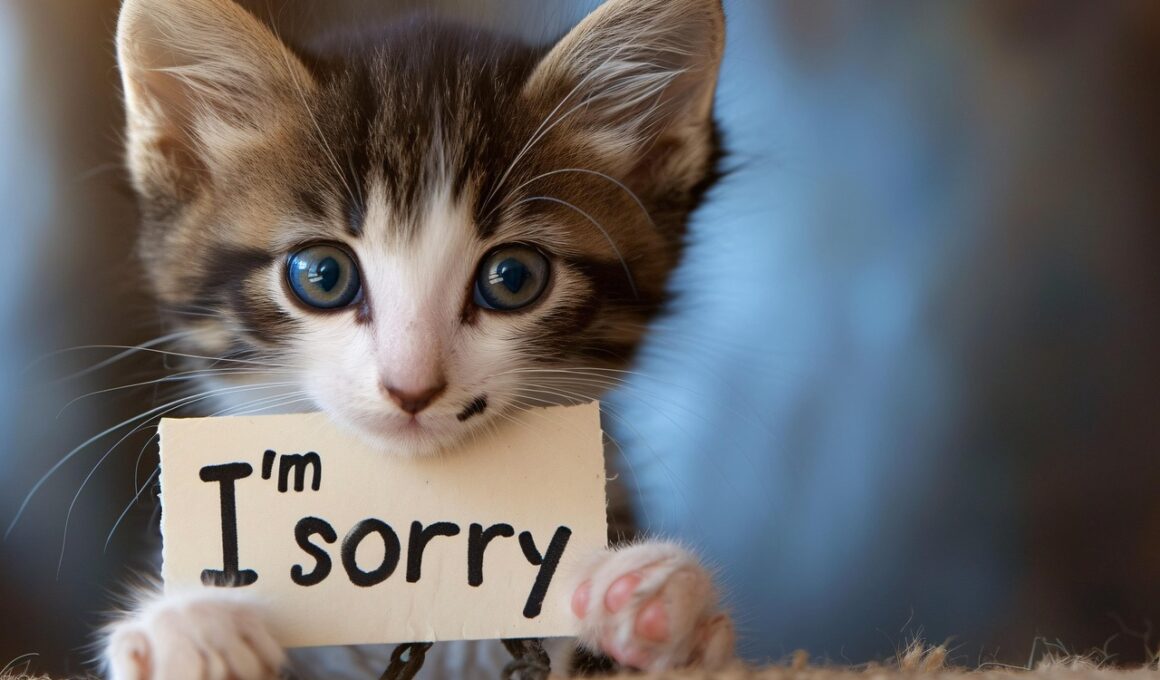How to Observe and Interpret Your Cat’s Whisker Language
Your cat’s whiskers are more than just facial adornments; they are highly sensitive tools that serve multiple purposes. Whiskers, or vibrissae, play a crucial role in helping your feline navigate its environment. Each whisker is equipped with nerves and blood vessels, allowing them to pick up on various tactile cues. Furthermore, whiskers are functional indicators of a cat’s emotional state, providing you with insight into how your cat is feeling. For instance, if the whiskers are relaxed and positioned forward, it typically indicates that your cat is curious and at ease. On the other hand, if they are pulled back against the face, your cat may feel threatened or uncomfortable. Therefore, it becomes essential to pay close attention to how these important sensory organs are positioned during interactions. By interpreting your cat’s whisker position, you can foster better communication and enhance the bond you share with your pet. Understanding your cat’s whisker language not only enriches your relationship but can also create a soothing environment for your beloved companion.
Whiskers play a vital role in how cats communicate not just with you, but with other felines as well. They use whisker positioning to express emotions, transmit signals, and convey intentions. A confident cat will display its whiskers forward, demonstrating self-assurance and openness to positive interactions. Conversely, a cat that feels threatened will draw its whiskers back, signifying distress or aggression. This behavior can be witnessed when your cat encounters unfamiliar pets or experiences a disruption in their environment. In moments like these, taking note of the whisker’s alignment could prevent any misinterpretations of your cat’s behavior. Other signs, such as an arched back or puffed tail, can accompany whisker movements and provide additional context. When engaging with your cat, take a moment to observe these signals closely. By understanding their nonverbal communication cues, you can create a stress-free space and encourage your cat to feel safe while interacting with others. A happy, relaxed cat typically exhibits a combination of pleased whisker positions, allowing pet owners to recognize when their feline is feeling satisfied and content.
Interpreting Whisker Behavior
To truly understand your feline friend, it is essential to observe not only the positioning of their whiskers but also the surrounding body language. Cats utilize their whiskers to measure the width of openings, which makes them feel more secure while navigating tight spaces. This natural instinct stems from their wild ancestors, who relied on precise measurements for survival. When you see your cat approaching a narrow space with paws out, whiskers slightly forward, it usually means they are genuinely comfortable with the surroundings. However, if you notice the whiskers retracting while stealthily observing its environment, it indicates caution or skepticism about the space they are entering. Understanding these subtle cues will strengthen your bond with your cat. It’s also essential to create an inviting environment where your cat feels safe exploring, as this will promote trust. Providing ample opportunities for your cat to engage naturally with their surroundings will further encourage healthy communication. This trust nurtures engagement and ultimately helps you become the best caregiver, allowing interpretations of their whisker language to become second nature.
Whiskers not only communicate your cat’s feelings but can also indicate their overall mood, particularly during playtime or when encountering new experiences. Observing your cat’s whiskers while they engage in these activities allows you to decipher their comfort level. A cat that enjoys play may actively extend its whiskers forward, hinting at eagerness and playfulness. In contrast, if the whiskers appear taut or rigid, it might signal that your cat feels overstimulated or anxious. Knowing when to step in and respect your cat’s boundaries can prevent unwanted stress. Additionally, watching your cat’s whiskers while they explore new environments might offer guidance on how to help them acclimate. The more relaxed the whiskers look, the more at ease your cat is with the situation. If they pull back suddenly, this could be a sign to reassess their environment. By recognizing these shifts in whisker positions, you can tailor experiences that promote a happier and more fulfilled feline. Ultimately, paying attention to whisker language fosters trust and understanding between you and your cherished companion.
The Importance of Whisker Health
Just as whiskers are important for communication, their health is critical to your cat’s overall well-being. Whiskers can become damaged, leading to discomfort and potential behavioral issues. Any signs of matted or damaged whiskers could indicate that your cat is facing challenges or stress within its environment. Similarly, if you notice excessive shedding or a lack of whisker sensitivity, it is essential to consult with a veterinarian to rule out any underlying health concerns. Keeping your cat’s whiskers healthy is especially important for their navigation skills and emotional state. Ensuring a safe and calm atmosphere will help maintain a healthy sensory experience. Regular grooming sessions contribute to whisker health as well, allowing you to notice any irregularities that may warrant attention. Lighting in your home can also be adapted to ensure your cat feels comfortable exploring, as dim lighting may create anxiety. By being proactive about whisker care and monitoring their condition, you enhance your cat’s quality of life and reduce any potential issues arising from compromised whiskers.
Being attuned to your cat’s whisker language can also improve your ability to respond to their needs effectively. When your cat expresses surprise or alarm, their whiskers may flare outward as a detection mechanism. If you observe this reaction, it indicates that your cat is encountering something unexpected, and providing comfort in that moment could ease their anxiety. In situations where your cat appears restless, the subtle movements of their whiskers can help you decipher feelings of boredom or unease. Engaging them in interactive play or providing stimulating toys can help ease their restlessness and encourage them to express enjoyment. By understanding how whiskers function in various scenarios, you empower yourself to be a more attentive owner. Additionally, forming an emotional bond with your cat cultivates a healthy environment for both of you. When you are in sync with their whiskers’ messages, you create a strong connection, fostering trust and respect. Ultimately, the goal is to establish a nurturing dynamic where your cat feels heard and understood, leading to an enriched life for both of you.
Enhancing Communication Through Observation
To ensure effective communication with your cat, be mindful of their environment, particularly when introducing new experiences or animals. Changes in their surroundings can lead to fluctuating whisker positions, which may indicate feelings of unease or curiosity. Observing the accompanying body language will provide a clearer insight into your cat’s emotional state. For instance, if a new pet comes to the house, tracking your cat’s whisker reactions will help account for their comfort level. A slow introduction allows your cat to approach the newcomer at their pace while observing whisker behaviors for appropriate responses. Your cat’s readiness to engage may reflect a more relaxed whisker posture. On the contrary, if you see whiskers drawn tightly against their face, it may indicate apprehension. Always respect these signals by creating a gradual transition into new experiences. This level of empathy enhances the bond between you and your furry friend, making them feel secure and understood during times of change. By valuing these whisker signals, you can foster a more cohesive and trusting relationship over time.
In summary, understanding your cat’s whisker language is vital for building a strong connection with your feline friend. Whiskers serve as communicative tools, providing insight into your cat’s emotions and desires. By paying attention to their positioning, you can accurately interpret feelings ranging from curiosity to unease. Regular observation and engagement in your cat’s environment can lead to improved communication and understanding, ultimately enhancing their overall happiness. By prioritizing whisker health and responding empathetically to changes in behavior, you create a nurturing atmosphere for your cat. A keen focus on whisker movements encourages you to become more attuned to your cat’s needs, elevating your bond to new heights. Incorporating playful interactions based on whisker cues can lead to a deeper connection that ensures your feline is both happy and secure. Remember that your attention to detail will highlight their emotional state and foster trust, allowing for a fulfilling experience for both of you. Ultimately, observing and interpreting your cat’s whisker language not only leads to a happier cat but also enriches the joy of pet ownership, making every moment with your furry companion more meaningful.


